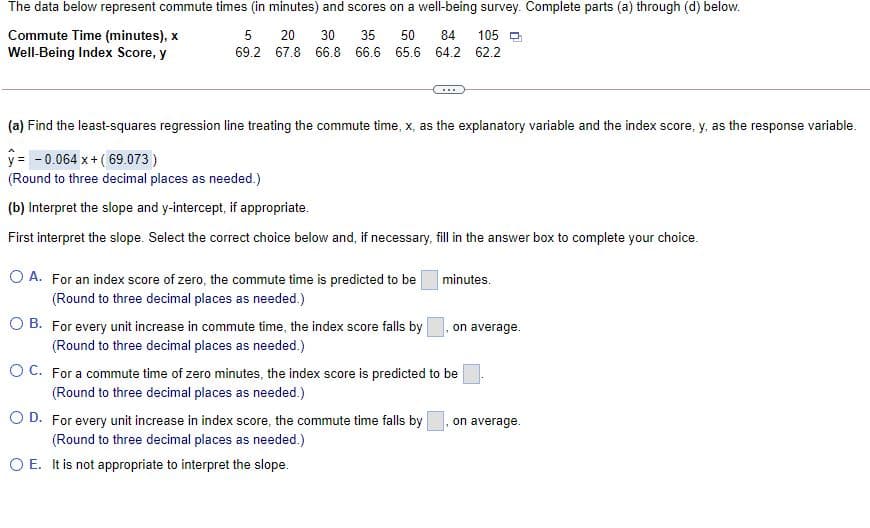The data below represent commute times (in minutes) and scores on a well-being survey. Complete parts (a) through (d) below. Commute Time (minutes), x Well-Being Index Score, y 5 20 30 35 50 84 105 D 69.2 67.8 66.8 66.6 65.6 64.2 62.2 (a) Find the least-squares regression line treating the commute time, x, as the explanatory variable and the index score, y, as the response variable. y = - 0.064 x+ ( 69.073 ) (Round to three decimal places as needed.) (b) Interpret the slope and y-intercept, if appropriate. First interpret the slope. Select the correct choice below and, if necessary, fill in the answer box to complete your choice. O A. For an index score of zero, the commute time is predicted to be minutes. (Round to three decimal places as needed.) O B. For every unit increase in commute time, the index score falls by on average. (Round to three decimal places as needed.) OC. For a commute time of zero minutes, the index score is predicted to be (Round to three decimal places as needed.) D. For every unit increase in index score, the commute time falls by on average. (Round to three decimal places as needed.) O E. It is not appropriate to interpret the slope.
The data below represent commute times (in minutes) and scores on a well-being survey. Complete parts (a) through (d) below. Commute Time (minutes), x Well-Being Index Score, y 5 20 30 35 50 84 105 D 69.2 67.8 66.8 66.6 65.6 64.2 62.2 (a) Find the least-squares regression line treating the commute time, x, as the explanatory variable and the index score, y, as the response variable. y = - 0.064 x+ ( 69.073 ) (Round to three decimal places as needed.) (b) Interpret the slope and y-intercept, if appropriate. First interpret the slope. Select the correct choice below and, if necessary, fill in the answer box to complete your choice. O A. For an index score of zero, the commute time is predicted to be minutes. (Round to three decimal places as needed.) O B. For every unit increase in commute time, the index score falls by on average. (Round to three decimal places as needed.) OC. For a commute time of zero minutes, the index score is predicted to be (Round to three decimal places as needed.) D. For every unit increase in index score, the commute time falls by on average. (Round to three decimal places as needed.) O E. It is not appropriate to interpret the slope.
Functions and Change: A Modeling Approach to College Algebra (MindTap Course List)
6th Edition
ISBN:9781337111348
Author:Bruce Crauder, Benny Evans, Alan Noell
Publisher:Bruce Crauder, Benny Evans, Alan Noell
Chapter3: Straight Lines And Linear Functions
Section3.CR: Chapter Review Exercises
Problem 15CR: Life Expectancy The following table shows the average life expectancy, in years, of a child born in...
Related questions
Question

Transcribed Image Text:The data below represent commute times (in minutes) and scores on a well-being survey. Complete parts (a) through (d) below.
Commute Time (minutes), x
Well-Being Index Score, y
5
20
30
35
50
84
105 O
69.2 67.8 66.8 66.6 65.6 64.2 62.2
(a) Find the least-squares regression line treating the commute time, x, as the explanatory variable and the index score, y, as the response variable.
y = - 0.064 x+ (69.073 )
(Round to three decimal places as needed.)
(b) Interpret the slope and y-intercept, if appropriate.
First interpret the slope. Select the correct choice below and, if necessary, fill in the answer box to complete your choice.
O A. For an index score of zero, the commute time is predicted to be
minutes.
(Round to three decimal places as needed.)
O B. For every unit increase in commute time, the index score falls by
on average.
(Round to three decimal places as needed.)
OC. For a commute time of zero minutes, the index score is predicted to be
(Round to three decimal places as needed.)
D. For every unit increase in index score, the commute time falls by
on average.
(Round to three decimal places as needed.)
O E. It is not appropriate to interpret the slope.
Expert Solution
This question has been solved!
Explore an expertly crafted, step-by-step solution for a thorough understanding of key concepts.
This is a popular solution!
Trending now
This is a popular solution!
Step by step
Solved in 3 steps

Recommended textbooks for you

Functions and Change: A Modeling Approach to Coll…
Algebra
ISBN:
9781337111348
Author:
Bruce Crauder, Benny Evans, Alan Noell
Publisher:
Cengage Learning

Elementary Linear Algebra (MindTap Course List)
Algebra
ISBN:
9781305658004
Author:
Ron Larson
Publisher:
Cengage Learning

Linear Algebra: A Modern Introduction
Algebra
ISBN:
9781285463247
Author:
David Poole
Publisher:
Cengage Learning

Functions and Change: A Modeling Approach to Coll…
Algebra
ISBN:
9781337111348
Author:
Bruce Crauder, Benny Evans, Alan Noell
Publisher:
Cengage Learning

Elementary Linear Algebra (MindTap Course List)
Algebra
ISBN:
9781305658004
Author:
Ron Larson
Publisher:
Cengage Learning

Linear Algebra: A Modern Introduction
Algebra
ISBN:
9781285463247
Author:
David Poole
Publisher:
Cengage Learning


Glencoe Algebra 1, Student Edition, 9780079039897…
Algebra
ISBN:
9780079039897
Author:
Carter
Publisher:
McGraw Hill

Algebra & Trigonometry with Analytic Geometry
Algebra
ISBN:
9781133382119
Author:
Swokowski
Publisher:
Cengage